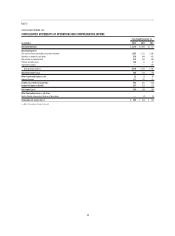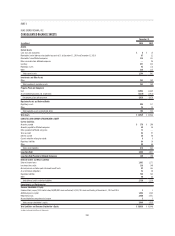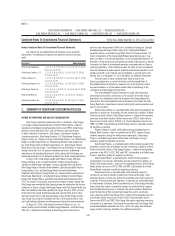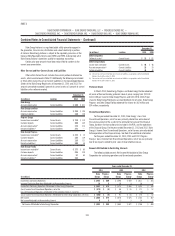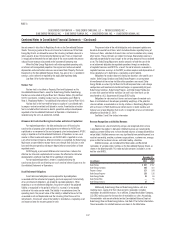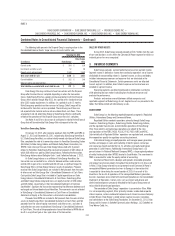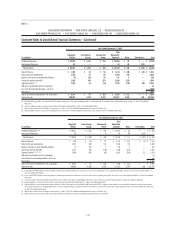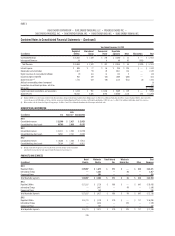Duke Energy 2014 Annual Report Download - page 127
Download and view the complete annual report
Please find page 127 of the 2014 Duke Energy annual report below. You can navigate through the pages in the report by either clicking on the pages listed below, or by using the keyword search tool below to find specific information within the annual report.
107
PART II
DUKE ENERGY CORPORATION • DUKE ENERGY CAROLINAS, LLC • PROGRESS ENERGY, INC. •
DUKE ENERGY PROGRESS, INC. • DUKE ENERGY FLORIDA, INC. • DUKE ENERGY OHIO, INC. • DUKE ENERGY INDIANA, INC.
Combined Notes to Consolidated Financial Statements – (Continued)
the net amount is classifi ed in Regulatory Assets on the Consolidated Balance
Sheets. The carrying value of the asset is based on historical cost if the Duke
Energy Registrants are allowed to recover the remaining net book value and a
return equal to at least the incremental borrowing rate. If not, an impairment
is recognized to the extent the net book value of the asset exceeds the present
value of future revenues discounted at the incremental borrowing rate.
When the Duke Energy Registrants sell entire regulated operating units,
or retire or sell nonregulated properties, the original cost and accumulated
depreciation and amortization balances are removed from Property, Plant and
Equipment on the Consolidated Balance Sheets. Any gain or loss is recorded in
earnings, unless otherwise required by the applicable regulatory body.
See Note 10 for further information.
Nuclear Fuel
Nuclear fuel is classifi ed as Property, Plant and Equipment on the
Consolidated Balance Sheets, except for Duke Energy Florida. Duke Energy
Florida has reclassifi ed all Crystal River Unit 3 Nuclear Station (Crystal River
Unit 3) investments, including nuclear fuel, to a regulatory asset. Refer to
Note 4, “Regulatory Matters,” for additional information on Crystal River Unit 3.
Nuclear fuel in the front-end fuel processing phase is considered work
in progress and not amortized until placed in service. Amortization of nuclear
fuel is included within Fuel used in electric generation and purchased power –
regulated in the Consolidated Statements of Operations. Amortization is
recorded using the units-of-production method.
Allowance for Funds Used During Construction and Interest Capitalized
For regulated operations, the debt and equity costs of fi nancing the
construction of property, plant and equipment are refl ected as AFUDC and
capitalized as a component of the cost of property, plant and equipment. AFUDC
equity is reported on the Consolidated Statements of Operations as non-cash
income in Other income and expenses, net. AFUDC debt is reported as a non-
cash offset to Interest Expense. After construction is completed, the Duke Energy
Registrants are permitted to recover these costs through their inclusion in rate
base and the corresponding subsequent depreciation or amortization of those
regulated assets.
AFUDC equity, a permanent difference for income taxes, reduces the
effective tax rate when capitalized and increases the effective tax rate when
depreciated or amortized. See Note 22 for additional information.
For nonregulated operations, interest is capitalized during the
construction phase with an offsetting non-cash credit to Interest Expense on the
Consolidated Statements of Operations.
Asset Retirement Obligations
Asset retirement obligations are recognized for legal obligations
associated with the retirement of property, plant and equipment. Substantially
all asset retirement obligations are related to regulated operations. When
recording an asset retirement obligation, the present value of the projected
liability is recognized in the period in which it is incurred, if a reasonable
estimate of fair value can be made. The liability is accreted over time. For
operating plants, the present value of the liability is added to the cost of the
associated asset and depreciated over the remaining life of the asset. For
retired plants, the present value of the liability is recorded as a regulatory asset
and expensed over the recovery period in rates.
The present value of the initial obligation and subsequent updates are
based on discounted cash fl ows, which include estimates regarding timing of
future cash fl ows, selection of discount rates and cost escalation rates, among
other factors. These estimates are subject to change. Depreciation expense is
adjusted prospectively for any changes to the carrying amount of the associated
asset. The Duke Energy Registrants receive amounts to fund the cost of the
asset retirement obligation for regulated operations through a combination
of regulated revenues and NDTF. As a result, the net of amounts recovered in
regulated revenues, earnings on the NDTF, accretion expense and depreciation of
the associated asset is deferred as a regulatory asset or liability.
Obligations for nuclear decommissioning are based on site-specifi c cost
studies. Duke Energy Carolinas and Duke Energy Progress assume prompt
dismantlement of the nuclear facilities after operations are ceased. Duke
Energy Florida assumes Crystal River Unit 3 will be placed into a safe storage
confi guration until eventual dismantlement begins in approximately 60 years.
Duke Energy Carolinas, Duke Energy Progress and Duke Energy Florida also
assume that spent fuel will be stored on site until such time that it can be
transferred to a U.S. Department of Energy (DOE) facility.
Obligations for closure of ash basins are based upon discounted cash
fl ows of estimated costs based upon probability weightings of the potential
closure methods as evaluated on a site-by-site basis. Duke Energy Registrants
with ash basins in North Carolina and certain basins in South Carolina and
Indiana have a legal obligation that results in recognition of an asset retirement
obligation at December 31, 2014.
See Notes 5 and 9 for further information.
Revenue Recognition and Unbilled Revenue
Revenues on sales of electricity and gas are recognized when service
is provided or the product is delivered. Unbilled revenues are recognized by
applying customer billing rates to the estimated volumes of energy delivered but
not yet billed. Unbilled revenues can vary signifi cantly from period to period as a
result of seasonality, weather, customer usage patterns, customer mix, average
price in effect for customer classes and meter reading schedules.
Unbilled revenues are included within Receivables and Restricted
receivables of variable interest entities on the Consolidated Balance Sheets as
shown in the following table. This table excludes amounts included in assets
held for sale (AHFS).
December 31,
(in millions) 2014 2013
Duke Energy $ 827 $ 937
Duke Energy Carolinas 295 323
Progress Energy 217 189
Duke Energy Progress 135 120
Duke Energy Florida 82 69
Duke Energy Ohio —55
Duke Energy Indiana 27 5
Additionally, Duke Energy Ohio and Duke Energy Indiana sell, on a
revolving basis, nearly all of their retail accounts receivable, including
receivables for unbilled revenues, to an affi liate, Cinergy Receivables Company,
LLC (CRC) and account for the transfers of receivables as sales. Accordingly,
the receivables sold are not refl ected on the Consolidated Balance Sheets of
Duke Energy Ohio and Duke Energy Indiana. See Note 17 for further information.
These receivables for unbilled revenues are shown in the table below.




